A common theme of this week’s titles is a well-told story revolving around books and reading to take readers on imaginative adventures, to whet the appetite for more books, and to kindle the desire to share the joy of reading with others. As book lovers, we know the power of books, but these works of literature bring home that belief and will inspire others.
Ages 4–8
Book Uncle and Me. Uma Krishnaswami. Ill. Julianna Swaney. 2016. Groundwood/House of Anansi.
 Nine-year-old Yasmin considers Book Uncle’s Lending Library on the corner of St. Mary’s Road and 1st Cross Street to be the best library in all of India. His sign reads, “Books. Free. / Give One. / Take One. / Read-read-read.” For Yasmin, who intends to read one book every day, forever, Book Uncle’s motto, “Right book for the right person for the right day” is perfect. And so, when the mayor shuts down Book Uncle’s bookstand for not having a permit, which he can’t afford, Yasmin knows she must do something. Inspired by the old Indian folk tale that Book Uncle selected for her, she enlists her friends, neighbors, and the entire community in what becomes a political campaign to oust Mayor S.L. Yogaraja (Mayor SLY) and elect a new mayor sympathetic to the importance of Book Uncle’s library to the town. This short chapter book offers a gentle lesson on how the initiative of one child may be an influence for change in a community.
Nine-year-old Yasmin considers Book Uncle’s Lending Library on the corner of St. Mary’s Road and 1st Cross Street to be the best library in all of India. His sign reads, “Books. Free. / Give One. / Take One. / Read-read-read.” For Yasmin, who intends to read one book every day, forever, Book Uncle’s motto, “Right book for the right person for the right day” is perfect. And so, when the mayor shuts down Book Uncle’s bookstand for not having a permit, which he can’t afford, Yasmin knows she must do something. Inspired by the old Indian folk tale that Book Uncle selected for her, she enlists her friends, neighbors, and the entire community in what becomes a political campaign to oust Mayor S.L. Yogaraja (Mayor SLY) and elect a new mayor sympathetic to the importance of Book Uncle’s library to the town. This short chapter book offers a gentle lesson on how the initiative of one child may be an influence for change in a community.
—CA
Dragon Was Terrible. Kelly DiPucchio. Ill. Greg Pizzoli. 2016. Farrar Straus Giroux.
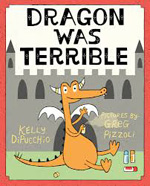 A chatty unseen narrator tells the tale of a “super terrible” (but, as the cartoon illustrations show, cute rather than fearsome) dragon, whose behavior in the kingdom becomes so intolerable that the king finally declares, “Enough!” and posts a reward for taming the terrible dragon. As knights and then “ordinary blokes and lassies” from the kingdom fail, the dragon becomes even more terrible (popping birthday balloons, painting graffiti on the drawbridge, and burping in church) until a young boy comes up with a clever dragon-taming plan involving a good book. His reward: a new friend—“A nice dragon, of course.”
A chatty unseen narrator tells the tale of a “super terrible” (but, as the cartoon illustrations show, cute rather than fearsome) dragon, whose behavior in the kingdom becomes so intolerable that the king finally declares, “Enough!” and posts a reward for taming the terrible dragon. As knights and then “ordinary blokes and lassies” from the kingdom fail, the dragon becomes even more terrible (popping birthday balloons, painting graffiti on the drawbridge, and burping in church) until a young boy comes up with a clever dragon-taming plan involving a good book. His reward: a new friend—“A nice dragon, of course.”
—CA
Madeline Finn and the Library Dog. Lisa Papp. 2016. Peachtree.
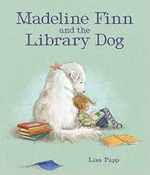 Madeline Finn does not like to read, especially out loud, because “sometimes the sentences get stuck in my mouth like peanut butter.” Although she desperately wants a star from her teacher for being a good reader, she gets only “Keep Trying” stickers. One day at the library, she meets Bonnie, a big white dog who encourages Madeline to patiently keep practicing. When she’s stuck on a word, Bonnie puts her big paws in Madeline’s lap and lets the young girl pet her until she figures it out. Every Saturday, Madeline returns to read to Bonnie. One day, when her teacher asks her to read aloud in class, Madeline pretends that she is reading to Bonnie, and she earns her first star. The realistic illustrations, rendered in watercolor, pencil, and digital coloring, capture the emotions of Madeline as she gains in experience and confidence through sharing stories with a library dog.
Madeline Finn does not like to read, especially out loud, because “sometimes the sentences get stuck in my mouth like peanut butter.” Although she desperately wants a star from her teacher for being a good reader, she gets only “Keep Trying” stickers. One day at the library, she meets Bonnie, a big white dog who encourages Madeline to patiently keep practicing. When she’s stuck on a word, Bonnie puts her big paws in Madeline’s lap and lets the young girl pet her until she figures it out. Every Saturday, Madeline returns to read to Bonnie. One day, when her teacher asks her to read aloud in class, Madeline pretends that she is reading to Bonnie, and she earns her first star. The realistic illustrations, rendered in watercolor, pencil, and digital coloring, capture the emotions of Madeline as she gains in experience and confidence through sharing stories with a library dog.
—NB
The Summer Nick Taught His Cats to Read. Curtis Manley. Ill. Kate Berube. 2016. Paula Wiseman/Simon & Schuster.
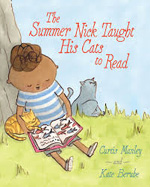 Nick loves to read. He wants his cats, Verne and Stevenson, to read with him, but they won’t. He even makes word flashcards to hook them. It’s only after Nick prints “Fish” that Verne is interested, practices reading words every day, and even gets his own library card. When Nick finds Stevenson’s secret stash of drawings, Verne and he write the narrative for a pirate story, The Tale of One-Eyed Stevenson and the Pirate Gold, and Stevenson becomes a reader, too. Wanting to have someone read aloud to him, Nick says to his cats, “Maybe I should teach you how to speak…How hard could that be?” Expressive, gently humorous illustrations, rendered in ink, Flashe paint, and acrylic paint, catch the spirit of Nick, his cats, and the joy of reading.
Nick loves to read. He wants his cats, Verne and Stevenson, to read with him, but they won’t. He even makes word flashcards to hook them. It’s only after Nick prints “Fish” that Verne is interested, practices reading words every day, and even gets his own library card. When Nick finds Stevenson’s secret stash of drawings, Verne and he write the narrative for a pirate story, The Tale of One-Eyed Stevenson and the Pirate Gold, and Stevenson becomes a reader, too. Wanting to have someone read aloud to him, Nick says to his cats, “Maybe I should teach you how to speak…How hard could that be?” Expressive, gently humorous illustrations, rendered in ink, Flashe paint, and acrylic paint, catch the spirit of Nick, his cats, and the joy of reading.
—NB
Wanted! Ralfy Rabbit, Book Burglar. Emily MacKenzie. 2016. Bloomsbury.
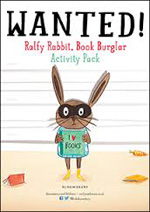 Ralfy, a prolific reading rabbit, “borrows” most of his books from people’s homes while they are sleeping. When he takes young Arthur’s favorite book, The Biggest Book of Monsters Ever, something must be done. After using his surveillance kit to catch Ralfy in action, Arthur reports the robbery to Officer Puddle only to be met with laughter until Ralfy pops up later in the officer’s home looking for more books. After identifying Ralfy in a hysterically funny lineup, Arthur comes up with a solution: They become book buddies at the public library, where books can always be borrowed (but must be returned). The cartoonlike artwork and clever wordplay (“Officer Puddle…told him he had caught the culprit read-handed!”) of this humorous picture book will delight young readers.
Ralfy, a prolific reading rabbit, “borrows” most of his books from people’s homes while they are sleeping. When he takes young Arthur’s favorite book, The Biggest Book of Monsters Ever, something must be done. After using his surveillance kit to catch Ralfy in action, Arthur reports the robbery to Officer Puddle only to be met with laughter until Ralfy pops up later in the officer’s home looking for more books. After identifying Ralfy in a hysterically funny lineup, Arthur comes up with a solution: They become book buddies at the public library, where books can always be borrowed (but must be returned). The cartoonlike artwork and clever wordplay (“Officer Puddle…told him he had caught the culprit read-handed!”) of this humorous picture book will delight young readers.
—NB
Ages 9–11
A Child of Books. Oliver Jeffers. Ill. Sam Winston. 2016. Candlewick.
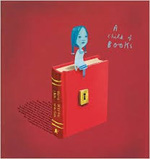 A young girl sitting aboard a raft reading a book identifies herself: “I am a child of books. I come from a world of stories.” She floats across a sea of words (lines from classic stories such as The Voyages of Doctor Dolittle and Gulliver’s Travels) to arrive at the home of a boy, who she invites to join her in an adventure around the world, scaling mountains, discovering treasure in a dark cave, playing in forests of fairy tales, escaping monsters in haunted castles, sleeping in clouds of lullabies, and shouting in outer space before finally ending in an explosion of colorful objects and characters from stories as they spin on a globe. She ends with an invitation to explore the imaginative power of reading books. The titles of all the books that are used in the typographically created landscape the children travel through are listed on the endpapers.
A young girl sitting aboard a raft reading a book identifies herself: “I am a child of books. I come from a world of stories.” She floats across a sea of words (lines from classic stories such as The Voyages of Doctor Dolittle and Gulliver’s Travels) to arrive at the home of a boy, who she invites to join her in an adventure around the world, scaling mountains, discovering treasure in a dark cave, playing in forests of fairy tales, escaping monsters in haunted castles, sleeping in clouds of lullabies, and shouting in outer space before finally ending in an explosion of colorful objects and characters from stories as they spin on a globe. She ends with an invitation to explore the imaginative power of reading books. The titles of all the books that are used in the typographically created landscape the children travel through are listed on the endpapers.
—CA
The Evil Wizard Smallbone. Delia Sherman. 2016. Candlewick.
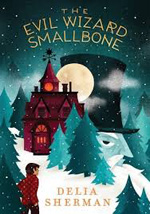 In this unusual hero cycle story, 12-year-old Nick runs away from his cruel uncle and cousin and right into Evil Wizard Smallbone and his magical bookstore, where he becomes an unwilling apprentice who grudges through each day doing anything but magic. After failed attempts to escape from Smallbone, Nick forms a bond with the bookstore and teaches himself magic by reading the books it systematically nudges his way. He realizes that there is something desperately wrong in Smallbone Cove—with breaches in its magically protected boundaries by Smallbone’s archrival, the Evil Wizard Fidelou—and comes up with a solution. There is a magical twist, however, that will keep readers on the edge of their seats until the last word of this satisfying fantasy.
In this unusual hero cycle story, 12-year-old Nick runs away from his cruel uncle and cousin and right into Evil Wizard Smallbone and his magical bookstore, where he becomes an unwilling apprentice who grudges through each day doing anything but magic. After failed attempts to escape from Smallbone, Nick forms a bond with the bookstore and teaches himself magic by reading the books it systematically nudges his way. He realizes that there is something desperately wrong in Smallbone Cove—with breaches in its magically protected boundaries by Smallbone’s archrival, the Evil Wizard Fidelou—and comes up with a solution. There is a magical twist, however, that will keep readers on the edge of their seats until the last word of this satisfying fantasy.
—NB
Sophie Quire and the Last Storyguard (Peter Nimble Adventure #2). Jonathan Auxier. 2016. Amulet/Abrams.
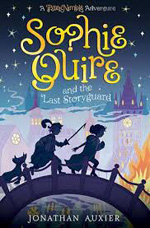 Twelve-year-old Sophie Quire, who lives a quiet life repairing books in her father’s bookstore, is worried about upcoming Pyre Day, on which Inquisitor Prigg intends to rid the town of Bustleburg of “nonsense” by burning all storybooks, when a strange blindfolded boy, Peter Nimble, and his furry, enchanted companion, Sir Tode, show up with a mysterious book, The Book of Who, in need of mending. Following clues from the magical book, Sophie and Peter, pursued by Inquisitor Prigg and his henchman, Torvald Knucklemeat, set out to find the book’s companion volumes (The Book of What, The Book of Where, and The Book of When). This fast-paced, action-packed adventure, in which Sophie must find and protect the books that contain all the magic that ever existed and use them to save stories and the world, ends with the promise of more adventure as she leaves a note on her work bench: “My tale is not yet told. I will return. Fondly, Sophie Quire, the Last Storyguard.”
Twelve-year-old Sophie Quire, who lives a quiet life repairing books in her father’s bookstore, is worried about upcoming Pyre Day, on which Inquisitor Prigg intends to rid the town of Bustleburg of “nonsense” by burning all storybooks, when a strange blindfolded boy, Peter Nimble, and his furry, enchanted companion, Sir Tode, show up with a mysterious book, The Book of Who, in need of mending. Following clues from the magical book, Sophie and Peter, pursued by Inquisitor Prigg and his henchman, Torvald Knucklemeat, set out to find the book’s companion volumes (The Book of What, The Book of Where, and The Book of When). This fast-paced, action-packed adventure, in which Sophie must find and protect the books that contain all the magic that ever existed and use them to save stories and the world, ends with the promise of more adventure as she leaves a note on her work bench: “My tale is not yet told. I will return. Fondly, Sophie Quire, the Last Storyguard.”
—CA
Ages 12–14
The Most Frightening Story Ever Told. Philip Kerr. 2016. Alfred A. Knopf/Random House.
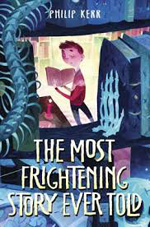 Twelve-year-old Billy Shivers, recovering from a car accident, spends his days at the Hitchcock Public Library until he discovers the creepy Haunted House of Books and its thematic rooms rigged with spooky traps. Billy soon convinces the owner, eccentric Mr. Rapscallion, to take him on as an unpaid apprentice. When Billy accompanies him to a conference, a child psychologist proposes that Mr. Rapscallion read a terrifying old manuscript to children at his bookstore so she can study how they respond. He agrees to combine this experiment with a midnight reading of the scariest-story-ever-written-in-the-whole-history-of-the-world contest as publicity for his bookstore and chooses five children (with Billy as one of them) to compete to win $1,000. After four of the contestants scurry out during the night, Billy is declared the winner. With the bookstore saved, Mr. Rapscallion attempts to deliver the prize money to Billy only to uncover an unbelievable secret. Young readers will be intrigued by short, scary stories that are interspersed throughout the novel.
Twelve-year-old Billy Shivers, recovering from a car accident, spends his days at the Hitchcock Public Library until he discovers the creepy Haunted House of Books and its thematic rooms rigged with spooky traps. Billy soon convinces the owner, eccentric Mr. Rapscallion, to take him on as an unpaid apprentice. When Billy accompanies him to a conference, a child psychologist proposes that Mr. Rapscallion read a terrifying old manuscript to children at his bookstore so she can study how they respond. He agrees to combine this experiment with a midnight reading of the scariest-story-ever-written-in-the-whole-history-of-the-world contest as publicity for his bookstore and chooses five children (with Billy as one of them) to compete to win $1,000. After four of the contestants scurry out during the night, Billy is declared the winner. With the bookstore saved, Mr. Rapscallion attempts to deliver the prize money to Billy only to uncover an unbelievable secret. Young readers will be intrigued by short, scary stories that are interspersed throughout the novel.
—NB
The Reader (Sea of Ink and Gold #1). Traci Chee. 2016. Putnam/Penguin.
 Sefia has been on the run with her Aunt Nin since her father was murdered. When her aunt is kidnapped, Sefia goes on the hunt for her and the truth about her father’s death, with only a knapsack holding a wrapped package, a book. Unbeknownst to her, she is pursued by assassins working for a secret society that wants the book returned at any cost. Sefia frees an imprisoned mute boy, and surviving brutal circumstances, they become a team. Although she grew up in a society in which literacy is banned, Sefia teaches herself to read the book, and finds herself caught up in complex stories of pirates and others she doesn’t understand. As she reads to the boy, Sefia eventually discovers they are in a just-in-time magical story that is unfolding before her eyes (literally). In this multilayered novel with three shifting time frames and things that are most likely not what they seem, Sefia learns secrets about her parents, herself, and her world as she negotiates through a dystopian landscape where forbidden words control the future.
Sefia has been on the run with her Aunt Nin since her father was murdered. When her aunt is kidnapped, Sefia goes on the hunt for her and the truth about her father’s death, with only a knapsack holding a wrapped package, a book. Unbeknownst to her, she is pursued by assassins working for a secret society that wants the book returned at any cost. Sefia frees an imprisoned mute boy, and surviving brutal circumstances, they become a team. Although she grew up in a society in which literacy is banned, Sefia teaches herself to read the book, and finds herself caught up in complex stories of pirates and others she doesn’t understand. As she reads to the boy, Sefia eventually discovers they are in a just-in-time magical story that is unfolding before her eyes (literally). In this multilayered novel with three shifting time frames and things that are most likely not what they seem, Sefia learns secrets about her parents, herself, and her world as she negotiates through a dystopian landscape where forbidden words control the future.
—NB
Ages 15+
Every Exquisite Thing. Matthew Quick. 2016. Little, Brown.
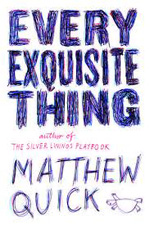 Privileged senior Nanette O’Hare is a college-bound dutiful daughter, straight-A student, and soccer star, but after she reads the mysterious cult classic The Bubblegum Reaper that her favorite teacher, Mr. Graves, gives her, she changes her life 180 degrees and becomes a rebel misfit. When her relationships with her parents, whose marriage is failing, and friends, from whom she alienates herself, spiral out of control, Nanette seeks out the author, Nigel Booker, for answers to questions the book has aroused in her. He won’t answer them but instead points her toward other writers. He also introduces her to a troubled young poet, Alex, with whom she falls in love. Together Nanette and Alex, along with a young boy they befriend, attempt to solve the mystery of why Booker wrote the book in the first place. Twists and turns in the labyrinth of self-discovery lead to tragedy, guilt, and, ultimately, to Nanette discovering her authentic self and what it is that she wants in her future.
Privileged senior Nanette O’Hare is a college-bound dutiful daughter, straight-A student, and soccer star, but after she reads the mysterious cult classic The Bubblegum Reaper that her favorite teacher, Mr. Graves, gives her, she changes her life 180 degrees and becomes a rebel misfit. When her relationships with her parents, whose marriage is failing, and friends, from whom she alienates herself, spiral out of control, Nanette seeks out the author, Nigel Booker, for answers to questions the book has aroused in her. He won’t answer them but instead points her toward other writers. He also introduces her to a troubled young poet, Alex, with whom she falls in love. Together Nanette and Alex, along with a young boy they befriend, attempt to solve the mystery of why Booker wrote the book in the first place. Twists and turns in the labyrinth of self-discovery lead to tragedy, guilt, and, ultimately, to Nanette discovering her authentic self and what it is that she wants in her future.
—NB
Nancy Brashear is Professor Emeritus of English from Azusa Pacific University, in Azusa, CA. Carolyn Angus is former director of the George G. Stone Center for Children's Books, Claremont Graduate University, in Claremont, CA.
These reviews are submitted by members of the International Literacy Association's Children's Literature and Reading Special Interest Group (CL/R SIG) and are published weekly on Literacy Daily.